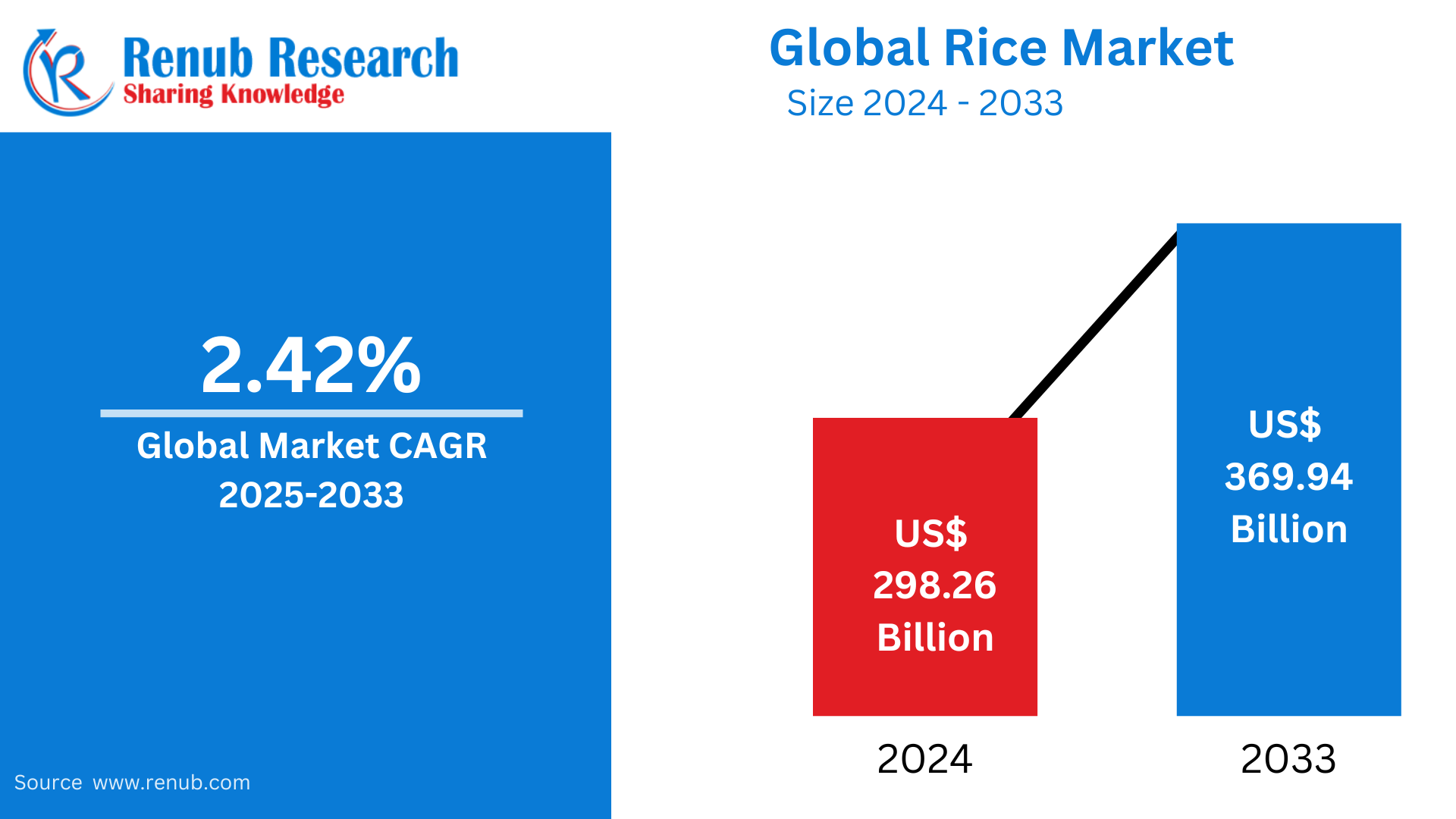Global Rice Market Forecast to Reach $378.41 Billion by 2033, Driven by Population Growth, Shifting Dietary Habits, and Government Support
Renub Research, a global leader in market research and consulting, has released its comprehensive analysis on the global rice market, with projections indicating substantial growth in the coming years. The Global Rice Market is expected to expand from US$ 305.14 billion in 2024 to US$ 378.41 billion by 2033, growing at a CAGR of 2.42% from 2025 to 2033. This growth is attributed to various factors, including population increase, urbanization, evolving dietary preferences, international trade agreements, and a rising demand for convenient rice-based food products.
Key Growth Drivers:
- Government Programs and Agricultural Policies: Numerous rice-producing countries are implementing policies to stabilize the rice market, promote rice production, and ensure food security. These policies, including price support systems and subsidies, are driving increased rice yields and making the industry more resilient to market fluctuations.
- Convenience Foods: Busy, urban populations are increasingly demanding quick and easy meal solutions. Ready-made rice products such as instant rice, rice bowls, and rice-based snacks are experiencing heightened demand.
- Globalization and Export Opportunities: International trade agreements are enhancing rice exports, and countries like India and Thailand are increasing their rice production to meet rising global demand.
Challenges in the Market: Despite strong growth prospects, the rice market faces several challenges, including:
- Price Volatility and Supply-Demand Imbalances: Fluctuations in price due to climatic conditions, disease outbreaks, and trade restrictions are creating uncertainties for producers and consumers alike.
- Climate Change: Adverse weather conditions, including floods and droughts, are affecting rice production, particularly in regions dependent on monsoon rains.
Key Market Segments:
- By Product Type: Regular and aromatic rice varieties are dominating the market, with demand for premium rice products like Basmati and Arborio growing.
- By Grain Size: Long-grain rice is expected to remain the preferred type, but medium and short-grain varieties are also seeing significant adoption.
- By Application: Food applications are the largest segment, but demand for rice in feed and other industries is also growing.
Regional Insights:
- Asia-Pacific: Home to the largest share of global rice consumption, with China and India being the top producers. Demand is also increasing in other Asian countries due to urbanization and dietary changes.
- North America: The U.S. rice market is growing due to increased consumption driven by diverse dietary habits and a rising food service industry.
- Middle East & Africa: The UAE, reliant on rice imports, continues to see high demand for Basmati and premium rice types.
Renub Research's report offers a detailed analysis of the rice market's growth trajectory, key trends, and competitive landscape. With in-depth market segmentation by product type, grain size, distribution channels, and application, the report provides valuable insights for businesses and stakeholders looking to capitalize on the expanding rice market.
New Publish Reports
· Europe Electric Vehicle Market Size and Share Analysis - Growth Trends and Forecast Report 2025-2033
FAQs:
1. What is the projected market size of the global rice market?
The global rice market is projected to reach US$ 378.41 billion by 2033, growing at a CAGR of 2.42% from 2025 to 2033.
2. What are the main factors driving the growth of the rice market?
Growth is driven by population growth, changing dietary habits, urbanization, government policies, and rising demand for convenience food made from rice.
3. Which regions are leading the global rice market?
Asia-Pacific, particularly China and India, leads the global rice market due to high production and consumption rates. Other regions like North America and the Middle East are also witnessing growing demand.
4. What are the major rice types that dominate the market?
Regular and aromatic rice types dominate the market, with varieties such as Basmati, Arborio, Black Rice, and Brown Rice gaining traction in both domestic and international markets.
5. How is the demand for convenience foods affecting the rice market?
The rising demand for quick and easy meal solutions, such as microwaveable rice and rice-based snacks, is boosting the convenience food segment, leading to higher consumption of rice products.
6. What are the challenges faced by the rice market?
The rice market faces challenges such as price volatility, supply-demand imbalances, climate change, and trade restrictions that can disrupt global rice supply chains.
7. Which countries are expected to drive the rice market's growth?
Countries such as India, China, and the United States are expected to play significant roles in market growth, along with rising export demand from emerging economies.
8. How does government policy impact the rice market?
Government policies, such as price support, subsidies, and agricultural reforms, help stabilize the rice market, support rice production, and ensure food security, particularly in rice-producing countries.
9. What are the primary applications of rice?
Rice is predominantly used in the food industry, but its applications in animal feed and other industries are growing.
10. Who are the key players in the rice market?
Major players in the rice industry include KRBL Limited, LT Foods Ltd, Kohinoor Foods, and General Mills, among others. These companies are driving innovation and market expansion through new product offerings and strategic partnerships.
For further information or to request a sample report, contact Renub Research today!




